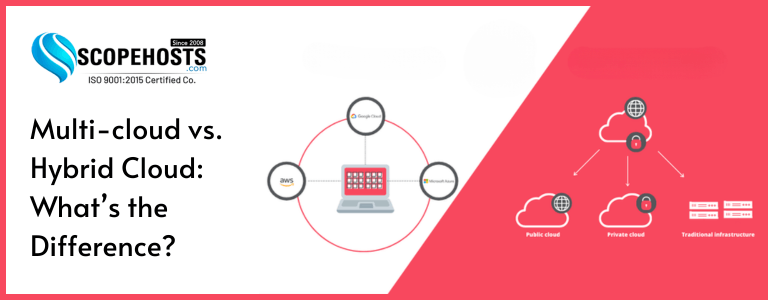Introduction
As cloud computing evolves, multi-cloud and hybrid cloud have emerged as leading enterprise IT strategies. Both models promote improved flexibility and performance but serve vastly different purposes. Making the right choice is crucial for optimizing infrastructure, controlling costs, and ensuring security. In this blog, we will explore both cloud strategies in depth and clarify how they are different to help you make a more informed decision.

What is a Hybrid Cloud?
A hybrid cloud integrates on-premises infrastructure (or a private cloud) with public cloud services to create a unified, interoperable environment. This allows organizations to keep sensitive workloads secured in their internal data center while assigning less sensitive workloads to the public cloud.
The objective is to ensure mobility across environments to enable workloads to shift, depending on the needs of the business, availability of resources, or a desire to optimize costs. This is ideal for industries with stringent regulations or low-latency requirements.
What is a Multi-cloud?
A multi-cloud strategy involves using two or more public cloud providers (e.g., AWS, Google Cloud, Microsoft Azure) to leverage the best-in-class services from each for different workloads. Unlike hybrid clouds, these environments are not necessarily interconnected; they operate independently.
When using a multi-cloud strategy, organizations can select services to utilize from each cloud provider in relation to a particular need, such as data storage, analytics, AI, or app hosting.
Architectural Comparison
Architecturally, hybrid and multi-cloud models differ fundamentally in both design and operational philosophy.
- Hybrid cloud focuses on integration, necessitating a unified orchestration framework that enables private and public environments to communicate securely and reliably. This usually includes container orchestration frameworks like Kubernetes, custom VPNs, and unified monitoring technologies.
- Multi-Cloud is fundamentally about distribution. Different public cloud environments might serve totally different purposes, and each environment stands alone with its own management. Interconnectivity is not the goal, but rather specialization and vendor flexibility.
- The architectural intent of each model dictates data flow, application design, and security policy enforcement.
Core Differences and Practical Implications
Comprehending what these cloud models mean in practice will help determine which is appropriate for your organization.
- Integration vs. Independence
- Data Control
- Vendor Strategy
- Complexity and Management
Hybrid cloud emphasizes a single architecture. Workloads may move between private and public clouds, and require tight integration. Multi-cloud does not intend the same fluidity. Workloads operate on independent clouds designed for specific tasks.
A hybrid environment allows businesses to exert greater control over where and how data is stored, which is significant for businesses dealing with sensitive or regulated data. Multi-cloud offers versatility but increases governance complexity due to the need to adhere to different provider policies.
Hybrid models often rely on a primary cloud vendor that integrates with on-premises infrastructure. Multi-cloud solutions allow companies to spread their footprint among multiple providers, avoiding vendor lock-in
Hybrid cloud involves managing the synchronization between two distinct ecosystems. Multi-cloud solutions themselves introduce many of their own management challenges, such as fragmenting security standards and multiple APIs and billing options, but they do not involve the underlying integration complexity related to hybrid models.

Benefits of Each Approach
Hybrid and multi-cloud deployments offer significant benefits, depending on your specific context and goals.
Hybrid Cloud Benefits
- Offers better security for sensitive workloads
- Enhances disaster recovery and business continuity
- Provides flexibility for dynamic workloads
- Useful in industries with compliance requirements
Multi-cloud Benefits
- Avoids dependence on a single cloud provider
- Offers access to best-in-class services from each vendor
- Supports global operations with improved latency control
- Enables competitive pricing and improved resilience
Although hybrid cloud is focused on control and compliance, multi-cloud is focused on innovation and flexibility.
Ideal Use Cases
Understanding the strengths of each strategy helps businesses align their infrastructure with strategic objectives.
Hybrid Cloud Use Case: A government agency maintains confidential data on its local servers, and utilizes the cloud for external public services, such as citizen portals.
Multi-cloud Use Case: A retailer utilizes AWS to host its website, Google Cloud to analyze and process customer data, and Azure as its enterprise tools, including Microsoft 365 and Active Directory.
Hybrid Cloud Use Case: A financial institution storing transaction records in a data center in accordance with regulations while utilizing AI in the cloud to detect fraudulent activities
Multi-cloud Use Case: A SaaS organization deploying its services across the clouds so that services remain available if one provider goes down.
Each strategy supports specific operational and strategic outcomes, and understanding those is important for planning.

Which Cloud Strategy Fits Your Business?
Choosing between hybrid and multi-cloud isn’t about finding a ‘better’ option Instead, you will consider which model best suits your organizational priorities and goals, regulatory environment, and IT maturity.
For organizations with highly sensitive data or subject to stringent compliance requirements, hybrid cloud may be the best option. It provides you with control and customization along with access to cloud-scale elasticity.
Conversely, if your company prioritizes vendor flexibility, speed to deployment, and access to the latest tools, the multi-cloud structure might be the better option. As it gives the best opportunity for innovation without locking your company into a single provider’s ecosystem.
In some cases, a combined approach is the solution—a hybrid cloud integrated with multiple public clouds. This hybrid offers centralized control while enabling greater options.
Conclusion
Both hybrid and multi-cloud are robust strategies. The choice hinges on your architectural priorities: integration and control versus distribution and diversity.
Even as cloud services mature and enterprise market needs evolve, the future might be less about hybrid versus multi-cloud, and more about how efficiently we can combine them. The optimal architecture is the one that enables your business to scale securely and innovate rapidly.






